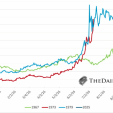Renminbi/Yuan Ascendancy And The Art Of War
 The Art of War by Sun Tzu is essentially a broad treatise on military strategies, written over five centuries ago. It has been studied and practiced in China and many other parts of Asia since it was authored. It has found use in Western society, as well, since the twentieth century. For the last few decades, however, China has been implementing it to fight the greatest war not involving military might – the war against the US dollar and the Western banking system.
The Art of War by Sun Tzu is essentially a broad treatise on military strategies, written over five centuries ago. It has been studied and practiced in China and many other parts of Asia since it was authored. It has found use in Western society, as well, since the twentieth century. For the last few decades, however, China has been implementing it to fight the greatest war not involving military might – the war against the US dollar and the Western banking system.
“The supreme art of war is to subdue the enemy without fighting.” – Sun Tzu, The Art of War
That the war has gone largely unnoticed in the West is testament to the craftiness of the Chinese.
“Engage people with what they expect; it is what they are able to discern, and confirms their projections. It settles them into predictable patterns of response, occupying their minds while you wait for the extraordinary moment – that which they cannot anticipate.” –Sun Tzu, The Art of War
We are now in the middle phase of this long, drawn out war. The first phase was fought on the economic front, and still is being fought, and it consisted of making labor fungible in order to take advantage of low labor rates in China. When China started this war, capital and materials were already fungible, but globalization brought labor into the picture, and put it on center stage.
“Appear weak when you are strong, and strong when you are weak.” - Sun Tzu, The Art of War
It is common knowledge that this kind of labor arbitrage resulted in the greatest dollar surpluses in history. By presenting itself as a weak economy more than thirty years ago, China was able to take advantage of globalization to make trade a one way street. Our largest exports in the last few decades have been jobs.
“Let your plans be dark and impenetrable as night, and when you move, fall like a thunderbolt.” – Sun Tzu, The Art of War
The dollar surpluses, however, were a legacy of a soon-to-be defunct monetary system. Enter the next phase. China realized the fragility of this monetary system from the very beginning, and formulated plans to overthrow the dollar’s reign. It recognized the fact that U.S. military might was built upon an Achilles heel of dollar supremacy. The system’s foundation was fragile because of the debt underlying this currency system. China’s long term strategy has been, and continues to be, to destroy the dollar based monetary system, and eventually, replace it with the Renminbi/yuan.
“Victorious warriors win first and then go to war, while defeated warriors go to war first, and then seek to win.” – Sun Tzu, The Art of War
By accumulating huge dollar surpluses, and then converting them into gold, China’s plans are to establish a new currency system based on gold reserves and trade surpluses. Some reports (Alasdair Macleod, for one) indicate that China has accumulated over 20,000 tonnes of gold. If China has not done this already, it makes sense for this figure to be China’s goal, as it would exceed the reserves of the U.S. and Western Europe combined. And none of it would be hypothecated. Already, talks are under way at the IMF and OMFIF to introduce the SDR as a world currency, with gold as a partial anchor. To this end, China has “requested” the IMF to add the Renminbi to the list of currencies comprising the SDR currently. These are the U.S. dollar, the Euro, the Japanese yen and the British pound. The word “requested” appears within quotes above because, I believe, that this is not a request from China to the IMF, but a subtle ultimatum. Should the IMF decline China’s “request”, China, along with other Asian and Middle Eastern nations, will threaten to establish a parallel currency system in competition with the SDR, and based upon gold reserves and trade surpluses, to the detriment of the SDR system. If two monetary systems exist simultaneously, one based on gold reserves and trade surpluses, and the other based on debt, there is little doubt that the debt laden system will collapse. A significant side effect of this would also be the end of Wall Street as we know it. Hence the recent article mentioned above that has received the endorsement from the CFR.
Therefore, the IMF has little recourse but to accept China’s Renminbi in its SDR basket. This is where things get really interesting. The IMF has a mandate to revise the components of its SDR basket every five years. There is little doubt that the Chinese Renminbi will enter that basket this year, as it has been five years since the last review of the SDR currency basket. If, as I surmise, the weight given to the currencies in the SDR will be in accordance with trade balances and gold reserves, it is fair to assume that the Chinese Renminbi will carry significant weightage. Regardless of the exact weight assigned to the Chinese Renminbi in the SDR basket this year, it must be borne in mind that this basket will be revised every five years. Once the new system is established, then, anytime China wants to increase the weight of the Renminbi in the system, all it will have to do is to disclose more of the gold already in its hold, or buy more with its surplus U.S. dollars.
This is a very well-conceived, long term plan on the part of China. It may stretch out to fifty years from the time of its original conception. But that’s how China strategizes.
By involving itself in territorial disputes in the South China Sea, China has evoked predictable responses from the West. Most of this, however, is diversionary. Its main purpose is ultimate Renminbi supremacy.
“If his (your enemy’s) forces are united, separate them.” – Sun Tzu, The Art of War
By involving the Renminbi in currency swaps with several countries, including those within the European Union, China has driven a wedge between the U.S. and the rest of the world. By creating a new development bank and the equivalent of the IMF among developing nations, China has gone a step further. It has rejected U.S. supremacy, which, in one way, is manifest through the IMF, because of the voting power of the U.S. in the IMF. And, it has created the China International Payment System (CIPS) as a bona fide rival to the Western SWIFT system of payments. China is determinedly out-maneuvering us every step of the way.
And the only response from the wise men and women in Washington and Brussels has been to inject various forms of liquidity in order to keep a crumbling system afloat.
A recent paper written by Robert D. Blackwill and Ashley J. Tellis, and endorsed by Richard Haas, President of the Council on Foreign Relations, specifically calls for a significant increase in the defense budget in order to contain China. Of course, an increase in defense spending can only come from ballooning deficits and debts that are not repayable, since Congress doesn’t have the backbone to cut any other programs. Articles such as this one draw chuckles, if not outright derision, from individuals who are able to differentiate between money and currencies. Currencies, being only a medium of exchange, can be created ex nihilo, whereas money, which is used as a medium of exchange, and, is a store of value, cannot. Can you guess which system is going to prevail? Can you guess which system the Chinese are about to impose upon the world? While economic and financial systems are in the limelight right now, try and remember that they both pay homage to the greater monetary god. Once the monetary regime changes, all rules have to be re-written; all debts have to be written off in some way, shape or form.
All this could have been avoided had there been no manipulation of precious metals pricing. Gold would have found its true market value years ago, whatever that may have been at any given moment, thereby making it very difficult for China to hoard as much as it has, which could be in the tens of thousands of tonnes. But that is water under the bridge. That moment has come and gone.
The Chinese hold all the cards now.

















